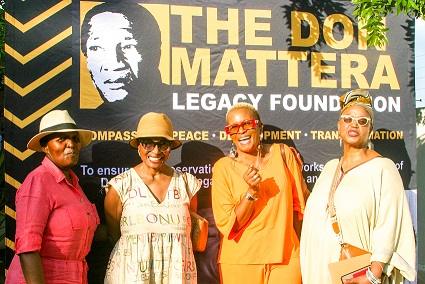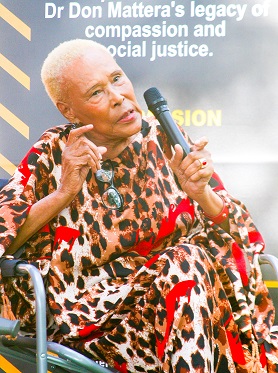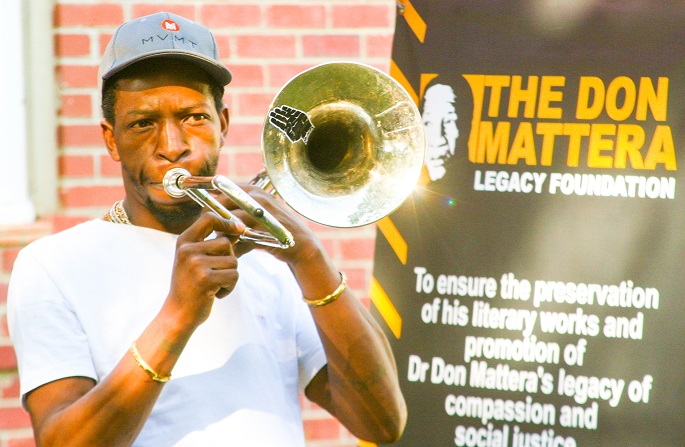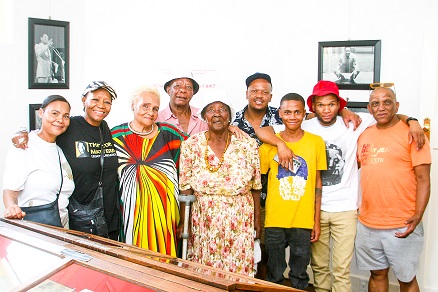BLACK History Month got off to a stirring start with the commemoration of the 70th anniversary of the ignominious Sophiatown forced removals of February 1955, at the Dr A.B. Xuma Museum in Sophiatown, as well as Chiefs House in Meadowlands, over the past weekend.
Hosted by the Don Mattera Legacy Foundation in partnership with the Wits History Workshop, the Dr A.B. Xuma Museum, the Trevor Huddleston Memorial Centre, Meadowlands Tourism Development Centre and Christ the King Church, the commemoration – which comprised of the launch of the Don Mattera Activation Exhibition, a reflective panel discussion in honour of the resilience and memory of residents who were forcibly removed from the area, as well as a commemorative walk from Sophiatown to Meadowlands intended to retrace the path of those who were displaced – was attended and partook in by erstwhile residents of Sophiatown, current Meadowlands residents and young and old visitors from around South Africa and overseas countries.
Launch of the Don Mattera Activation Exhibition
The two-day event commenced on the balmy summer Saturday at the erstwhile home of ex-ANC president, Dr A.B. Xuma and his wife, Madie Hall (an African-American social activist who became the ANC Women’s League’s first president) – one of two houses left unscathed during the demolition of Sophiatown – with the launch of the Don Mattera Activation Exhibition, a multi-media display curated by an NPO named Heritage Nexus and presented under the aegis of the Don Mattera Legacy Foundation.
The exhibition, titled, The Day They Came For Our House, reflects Sophiatown’s history as it appertained to both the late poet-activist and others and is presented in the form of audiovisual footage, family album photographs, newspaper cuttings, archival documents, books and canvases inscribed with some of his poems, which include the one lending its title to the exhibition’s, and which agonizingly recites partly thus: Armed with bulldozers they came to do a job nothing more, just hired killers. We gave way, there was nothing we could do, although the bitterness stung in us and in the earth around us.
Amanda Xulu, the Director of Heritage Nexus – an entity involved in grassroots heritage work and whose mission is to assist communities in telling their own stories, and which installed the display – revealed that the exhibition, which will be showing for the next six months, was meant for mixed audiences which include schoolchildren, and although at its initial phase, is intended for a countrywide tour.
Xulu’s vision was echoed by Mattera’s daughter, Snowy, who added that the activation is geared towards communities understanding history.
The day’s programme incorporated a panel discussion facilitated by radio presenter Brenda Sisane, which reflected on Sophiatown’s significance in Mattera’s life, writing and the enduring impact of the forced removals. Among participants were Mattera’s sister, Grace who relived a haunting memory depicting her otherwise proud grandfather leaning on his cane as he watched the veranda of the family’s house on 16 Gerty Street reduce into a heap of rubble.
Holding in rapt attention an audience which included some of her brother’s children and first wife, the 72-year-old disclosed how Black policemen collaborated in the demolition of their kindred’s homes as they barked orders, “ya wena nja, phuma la!” (you dogs, get out of here).
She went on to describe Mattera – who was the leader of The Vultures (a gang which took its name from a film named Where No Vultures Fly and which provided the youth of Sophiatown with a sense of identity and belonging), both reputable and feared for his ‘Zinga Special’ punch which landed many a foe at Coronation Hospital with broken jaws – as “everybody’s brother” who instilled love in her.
Another erstwhile ‘Kofifi’ (as old-timers refer to the place) resident present was Pinky Mabuza-Tiro, who along with her famous sister, Felicia, grew up in the neighbourhood before their family was abruptly uprooted.
She had visitors – who included current Sophiatown resident, dancer, Nomsa Manaka – contorted with laughter as she related anecdotes which included Mattera once remarking, “Ey, jy slaan jou klere”, alluding to her impeccable sense of dress!
Also contributing was 88-year-old Michael Adams, another erstwhile resident, who took those not au fait with the neighbourhood’s history down memory’s lane through his vivid limning of venues which hosted events such as ballroom dancing and personalities such as a boxer known as ‘One-eye Ace’ and Dyke, a neighbour of Adams’ who happened to be the Berliners Gang honcho.

Journalist, Phil Mthimkhulu, who resided at Meyer Street together with his rent collector father expounded on his impressions of ‘Bra Zinga’ – describing his fellow scribe as a pacifist and someone who was generous with money. Adding to the atmosphere of the occasion, guests were also treated to a trombone performance by jazz musician-cum-artist Malcolm Jiyane – who also had on display a huge painting titled ‘Surefiretown’ – augmented further by the Kwela sounds of Mango Groove.
About Sophiatown and Forced Removals
In the early hours of the morning of February 9, 1955 bulldozers rolled into Sophiatown – a neighbourhood of Johannesburg in which Black people held freehold tenure – accompanied by 2000 policemen armed with rifles and batons and raring to enforce eviction orders as they barked in the darkness: “Maak julle oop!” (“Open up!) 110 families would be forced to remove belongings from their homes, pile them onto trucks and be transported to Meadowlands, some 15 kilometres away in Soweto where hundreds of matchbox houses awaited occupancy.
One of the last areas of Black home-ownership in Johannesburg, Sophiatown, was home to a cosmopolitan mix of 65,000 people – black, white, mixed-race, Indian and Chinese – teeming with renowned jazz players, writers and artists!
Five years earlier, South Africa’s parliament had passed the Group Areas Act, intended to purge Black from developed neighbourhoods. In the early 1950s, the apartheid government began planning its demolition, citing poor living conditions and violence in the settlement as a reason.
Months ahead of the evictions, the African National Congress had been campaigning against the intended action by rallying residents through acts of defiance such as, WE WON’T MOVE slogans painted onto walls along streets. After the then racist regime’s foot soldiers had carried out such a blatant act of urban apartheid, the place was renamed Triomf (Afrikaans for triumph).
In February 2006, on the 50th anniversary of the eviction, the then Johannesburg Mayor Amos Masondo changed the name back to Sophiatown.
Commemorative Walk from Sophiatown to Meadowlands
On the Sunday morning of precisely the month and day seventy years ago that the forced removals commenced, participants from the Meadowlands Tourism Development Centre, The Don Mattera Legacy Foundation, residents and members of the media corps embarked on a 13 kilometre walk from the Trevor Huddleston Memorial Centre in Sophiatown en-route to Chiefs House in Meadowlands – to retrace the path of those displaced all those years back.
The walk was meant to be in solidarity with those who are presently reclaiming their right to the city of Johannesburg and was furthermore intended to echo Don Mattera’s call to utilize memory as a weapon and a tool for justice and preservation.

Among the walkers was Morten Ranum, a Danish journalist who offered that he was wooed into participating in the two-day event after experiencing a strong spiritual and emotional pull after initially having been interested in reporting on destroyed neighbourhoods such as Sophiatown, District 6 and Cato Manor.
The pedestrians route took in numerous itineraries which included Reverend Frederick Modise House (which back then was utilized by the Native Resettlement Board as a reception office where residents who arrived from Western Native Areas were processed), en-route to Chiefs House (a place built in the late 1950s to accommodate homeland chiefs such as Kaiser Matanzima, Mangosuthu Buthelezi and Patrick Mphephu on their visits to the urban areas) in Zone 4 Meadowlands where an absorbing exhibition titled, From Sophia to Ndofaya, awaited visitors to behold, as part of festivities rolled out in celebrating the resilience of the community.
The occasion induced reminiscence of the old-timers rallying song, Meadowlands, with its nonchalant refrain: You’ll hear the Whites say: let’s move to Meadowlands; Meadowlands, Meadowlands, Meadowlands my love. You’ll hear the tsotsis say: Ons dak nie, ons pola hier (We’re not moving, we’re staying here).
Top Image Jacob MAWELA (The Mattera clan at the launch of Don Mattera’s exhibition at the Dr AB Xuma Museum, Sophiatown).



